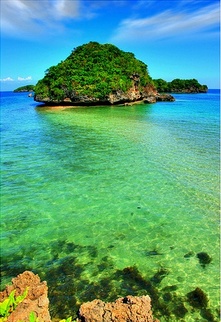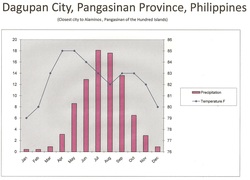Climatology of the Hundred Islands
Climate

Another view of an Island of the Hundred Islands
Prevailing Climate of the Hundred Islands
As is mentioned on the home page, average temperature of the Hundred Islands is around 82 degrees Fahrenheit year round, and the average precipitation is around 85.9 centimeters per year.
The overall climate of the Hundred Islands is warm and moist; however, as is shown in the climatograph depicted below, temperatures of the area do not remain in these set numbers for the entire year. The temperature fluctuates with the seasons, as it does in most other biomes.
Limiting Factors
The productivitiy of the Ocean Intertidal Zone is limited by the space available. Food is plentiful in this biome; the problem lies with the space necessary to grow and survive in an ecosystem. This limits the number of plants and organisms that can peacefully coexist in a certain area of the intertidal zone.
What is a Climatograph?
A climatograph is a graphical representation of the average weather and climate conditions in a biome during a certain time frame. These can come in handy when studying the overall trends and weather patterns of an area over time. Below is a climatograph of the Hundred Islands, which will show you, further, why you must visit the Hundred Islands; it's difficult to find such a wonderful climate and organisms!
A Climatograph of the Hundred Islands

Created by Jo Ortillo
This climatograph of the Hundred Islands, or more specifically, Dagupan City of the Pangasinan Province of the Phillipines, depicts the temperature and precipiation levels over the course of a year in the Hundred Islands.
My colleague, Jo Ortillo, created this specifically for the purpose of showing the climate present in the Hundred Islands.
The wonderful range of temperature and precipitation over the course of a year allude to the beauty and mystery of the Hundred Islands as a vacation spot. Come in the winter, summer, spring, or fall, there will be a different range of temperatures and climate that is available for you to experience.
The Hundred Islands is truly the ideal tourist destination. Book your tickets today!
My colleague, Jo Ortillo, created this specifically for the purpose of showing the climate present in the Hundred Islands.
The wonderful range of temperature and precipitation over the course of a year allude to the beauty and mystery of the Hundred Islands as a vacation spot. Come in the winter, summer, spring, or fall, there will be a different range of temperatures and climate that is available for you to experience.
The Hundred Islands is truly the ideal tourist destination. Book your tickets today!
Limiting Factors - Marine Ecosystems
Limiting factors for marine ecosystems (including the intertidal zone) include:
- Salinity of the water
- Pressure
- Light
- Tides
Light Layers
In the ocean, there are different layers, classified based on the amount of light they receive in each layer. (You can think of these as the layers of a rainforest- beginning with the canopy all the way down to the floor layer- the canopy obviously gets the most sunlight.)
- Photic Zone - This is where light is able to penetrate, and organisms that live in this zone depend on sunlight as their source of energy, whether directly (if they're photosynthesizing) or indirectly (if they consume photosynthetic organisms to obtain energy). This usually goes about 30 meters deep, but organisms may travel as much as 100 meters deep and still be considered part of this zone because they must return to this layer to garner the sustenance they require to survive.
- Aphotic Zone - As its name implies, this is a layer where light is unable to penetrate to a level that is useable by most photosynthetic organisms. As a result, organisms that live in this zone depend on energy sources such as geothermal energy, though there are a few photosynthetic organisms that absorb wavelengths of light that penetrate deeper into the water.
Sources:
"Dagupan, Philippines". Weatherbase.com. 2010. World Wide Web. <http://www.weatherbase.com/weather/weather.php3?s=52389&refer=>.
Picture Sources:
Bora-Dise. Hundred Islands. VMH Gulfville. 2010.
Copyright 2010 Meera Patel and Jo
